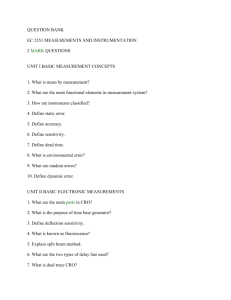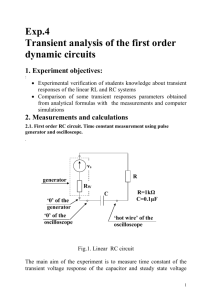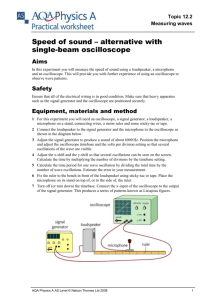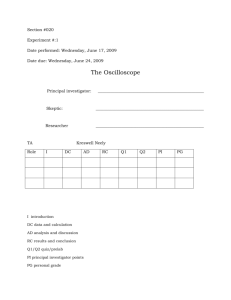Lab 13 help
advertisement
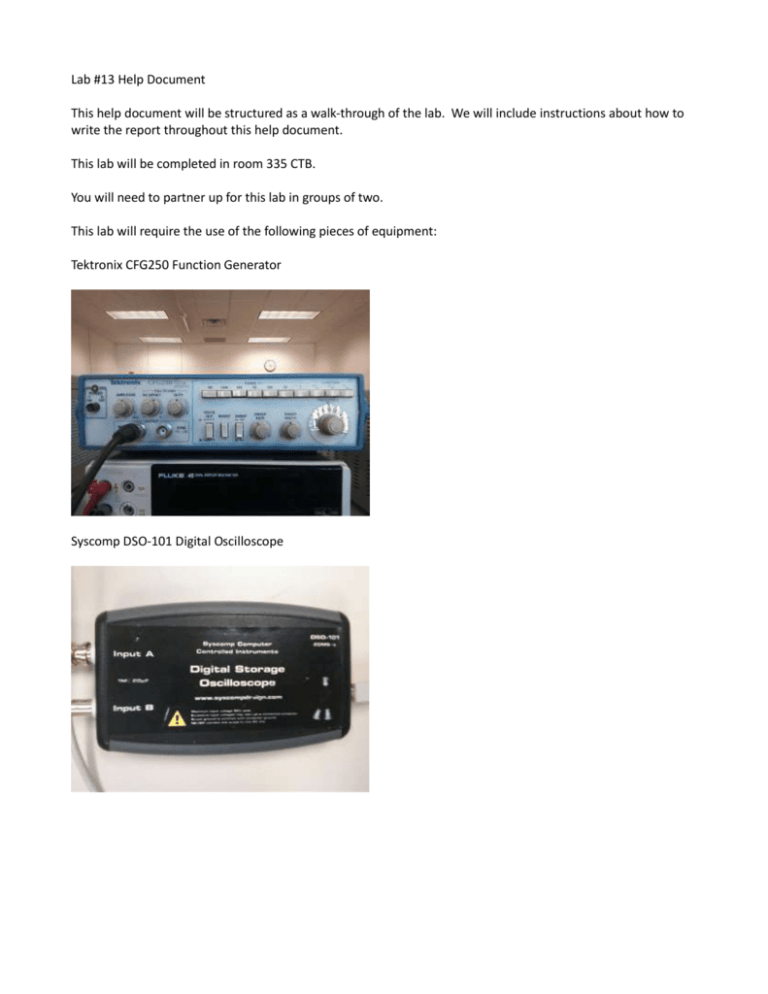
Lab #13 Help Document This help document will be structured as a walk-through of the lab. We will include instructions about how to write the report throughout this help document. This lab will be completed in room 335 CTB. You will need to partner up for this lab in groups of two. This lab will require the use of the following pieces of equipment: Tektronix CFG250 Function Generator Syscomp DSO-101 Digital Oscilloscope 100 Ohm resistor 2 Connection Clips Paired Wires Twisted Pair of Wires Ribbon Cable Coaxial Cable Ethernet Networking Cable Procedure Set up a lab station with an oscilloscope and a function generator. Set up the function generator so that a 1Mhz, 100mV square wave is being generated. Feed this signal over a transmission medium to a resistor. Measure and draw diagrams (or take pictures) of the input and output waveforms. Analyze what you observe in terms of distortion (little bumps throughout the waveform), noise (spikes on the waveform), attenuation (reduction in amplitude), etc. The transmission media are: 1. Pair of wires 2. Twisted pair of wires 3. Ribbon cable 4. Coaxial cable 5. Network cable The first thing that you need to do is set the function generator. Set the generator to generate a 1MHz square wave by pressing the 1M button, the square wave button, and setting the Frequency to 1.0. Now open the Syncomp Digital Oscilloscope located in START ALL PROGRAMS ACCESSORIES SYNCOMP DIGITAL OSCILLOSCOPE (folder) Syncomp Digital Oscilloscope. Open the program and make sure that it is connected with the physical device on your desk. When connected, check the signal from the function generator using input A of the digital oscilloscope to make sure that it is emitting the proper signal. Adjust the Frequency dial as necessary until the oscilloscope measures a 1MHz frequency. Also adjust the amplitude knob on the function generator until the oscilloscope reads 100mVp-p voltage. Note that you will need to zoom in on your Timebase controls to 500ns and the voltage scale for channel A to 100mV for the signal to be read properly by the oscilloscope (see second picture below). The wave pattern that you see will not be a perfect square wave. This is fine. Once your signal is set, you will need to perform the following steps for each of the signal transmission medium: Configure the Function Generator, Oscilloscope, Transmission medium, and 100 Ohm resistor such that they are connected as follows: Red lead of function generator to one wire on one end. Black lead of function generator to second wire on same end. Connect the resistor to the opposite end of the medium such that one lead connects to one wire and the other end connects to the other wire. Use connection clips to connect the resistor to the transmission medium. Connect the probe of input A from your oscilloscope to the same wire and end as the red lead from the function generator. Connect the ground from input A of the oscilloscope to the same wire and end as the black lead of the function generator. Connect the probe of input B from your oscilloscope so that it is between the wire that the red lead of the function generator is attached to and the resistor. Connect the ground of input B of the oscilloscope to the opposite end of the resistor from the probe of input B. The circuit should now appear as it does in the diagram below: Once the circuit is correctly set up, look at the signals being read by your oscilloscope. Measure and draw diagrams (or take pictures) of the input and output waveforms. If you want, you can take a screen shot of the oscilloscope such as the one shown below: This will count as a measurement and a diagram since it shows the values for both waveforms and their appearance. Next, analyze the waves (compare them) using these parameters: distortion (little bumps throughout the waveform) – does the output signal (input B) appear rougher than the input signal (input A)? does it have the same shape? If it is rougher and/or has a different shape, there is distortion present. noise (spikes on the waveform) – does B appear to have spikes that were not present in wave A? Spikes in signal B are signs of noise. attenuation (reduction in amplitude) - does B appear to have a greater or reduced amplitude than A? If so, signal B has attenuation. anything else that you notice – one example of another feature you will notice on at least one of these is a phase shift of the wave, meaning signal B will be shifted to the right of signal A. This is due to the lag/delay between the signal being sent at input A and being received at input B. Include any other anomalies that you see that haven’t already been referenced. For your lab report: Include a general description of how the circuit was set up. This can use words and/or pictures and they must describe how the signal from the function generator was connected to the oscilloscope to test the signal and how the components were connected to form the circuit (a circuit diagram will suffice for this). For each of the 5 different transmission mediums, include a diagram and measurements for the wave forms (remember that this can be done with a single picture if you use the method described in the above section). You also need to include an analysis where you compare the two waves in terms of distortion, noise, attenuation, and any other anomalies that occur. Report and Conclusion Give a comparative analysis of the transmission media covered. What would you expect the relative costs to be? This needs to be an analysis that compares the performance of the different transmission medium. If you want, you can show the bulk of this in the form of a table where you rank the performance in terms of distortion, noise, and attenuation and also provide a ranking for what you would expect their costs to be relative to each other. After this, offer a brief summary (one or two sentences) of the table for explanation purposes. You can also offer a verbal comparison of the different medium if you prefer. If you have any additional thoughts or conclusions you wish to state, please do so. If not, your table with brief explanation or verbal comparison will be sufficient for this section.


